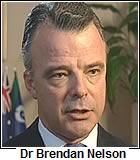 The
Minister, the Doorstop and Voluntary Student Unionism. (August 25, 2005)
The
Minister, the Doorstop and Voluntary Student Unionism. (August 25, 2005)
|
News & Views item - August 2005 |
![]()

The Minister for Education, Science and Training, Brendan Nelson, was at the steps of the Art Gallery of New South Wales yesterday and took time to give a doorstop interview. Not surprisingly journalists were interested in getting the minister's latest views on the issue of voluntary student unionism. On careful reading it looks as if the minister is leaving himself just a bit of wiggle room.
JOURNALIST:
Thereís no compromise as far as you are concerned? There is no way that the Government can compromise any way on it, wanting to get rid of the student unions?
DR NELSON:
Well, the Howard Government knows what it stands for and on three occasions we have presented legislation to the federal parliament that would allow Australian university students to make a choice as to whether they will join a student union, guild or association or not. We are determined to see this policy through. We think that students have a right to choose what they will spend their hard-earned money on, whether they want to join the beer drinking club, the toga club, political, cultural or sporting organisations. We also think that in the twenty-first century especially, whether they are in cities or in regional campuses, there are lots of services which can and will be provided, not only by students choosing to spend their money on them, but also by universities themselves supporting them.
Those who are arguing that Laborís policy is in some way something to be supported need to answer one basic question. Why should a young bloke who is training to be a doctor, and playing rugby part-time, be supported with a scholarship, accommodation and a part-time job and be subsidised in the process by a single mother with two kids who is trying to get a university education. The Howard Government believes in choice. We donít believe in flat taxes. People go to university to get an education. They shouldnít be forced to pay up front fees for services and goods they neither want nor need.
JOURNALIST:
Just on that single mother with the two kids. Wonít child care suffer, particularly in regional unis, if there is no compulsory service fee?
DR NELSON:
Well, in fact, child care in Australian universities is subsidised by the union fee in only one quarter of cases, and in half of the cases where child care is subsidised itís actually more expensive than un-subsidised child care. You only have to look, for example, in Sydney at the Magic Pudding Child Care Centre at UTS. The students are subsidising child care for staff to the tune of $3 a day, and further to that if you go around the corner to Ultimo you will pay the same price in an unsubsidised child care place, or you can get it cheaper at Darling Harbour. The reality is that whatís happening in child care on Australian university campuses is that up to 30,000 students apparently have to pay a compulsory up-front student fee, a flat tax, and then apparently the subsidised child care for staff as well as students, when in many cases the unsubsidised child care on-campus and off-campus is cheaper than that they are subsidising.
JOURNALIST:
So Brendan, what you are saying is that in universities subsidised child care is more expensive, yet Government subsidies for child care which are being announced by your Government donít make child care more expensive?
DR NELSON:
We have a University of New South Wales study of child care of eight of the largest universities in Australia. We know from that study, in only one quarter of the cases is the child care is actually subsidised, and in half of the cases where itís subsidised by union fees, the places are taken up by staff, and itís actually dearer than unsubsidised child care. The Australian Government is providing several billion dollars in child care subsidies to working Australian right across the country. University students access those child care subsidies along with every other Australian, and in the twenty-first century, why should students pay federal taxes, state taxes, local government taxes, and then have to pay another tax when they turn up at university just because they want to get an education? Fifteen percent of Australian university students have to pay a compulsory up-front charge, which is also Mr Beazleyís plan, and yet they never set foot on the campus because they are studying by computers on distance learning.
Below we reproduce the AVCC's table of where the funds for students' services and amenities are derived and on what they are spent. It takes only cursory scrutiny to demonstrate Dr Nelson's glib disingenuousness when he repeats once again his rhetorical question, "Why should a young bloke who is training to be a doctor, and playing rugby part-time, be supported with a scholarship, accommodation and a part-time job and be subsidised in the process by a single mother with two kids who is trying to get a university education?"
19.40% of student body funding goes to sporting facilities, 80.60% does not. Currently of that 80.60% "advocacy, representation and political activity" constitutes 17.21%. That leaves just over 63% for services and amenities other than sporting facilities or "advocacy, representation and political activity". And is the former general practitioner really suggesting that the mother of two never uses the universities' sporting facilities... because if so... well let's just say that would be ah... misleading.
While Dr Nelson is yet to assume the Treasurer's mantle, the concept of "cross subsidisation" is unlikely to be entirely foreign to him.
|
|
|
Table prepared by AVCC |
Noted in passing: Signs posted in the toilets at The University of Sydney
read These toilets cleaned using fee money.